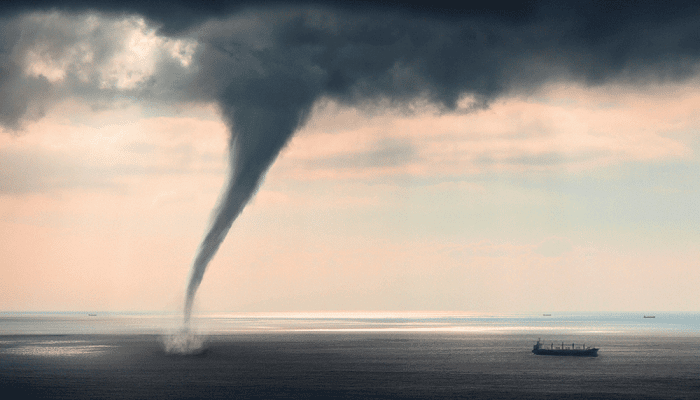Learn in this article how much energy a hurricane can produce!
Hurricanes: What are they?
Hurricanes are a type of tropical storm that occur in the North Atlantic, Caribbean and South Pacific. They are formed when sea water is very warm and humidity is high. The kinetic energy of the winds around the center of the storm can reach 300 km/h.
Hurricanes are classified into five categories according to the intensity of the winds:
Category 1: winds up to 119 km/h;
Category 2: winds from 120 to 153 km/h;
Category 3: winds from 154 to 177 km/h;
Category 4: winds from 178 to 209 km/h;
Category 5: winds above 210 km/h.
The History of Hurricanes
The history of hurricanes is long and full of interesting facts. Hurricanes are tropical storms that form in the warm waters of the Atlantic Ocean, the Gulf of Mexico and the Central Pacific Region. These storms can be extremely destructive, with winds reaching speeds of over 200 miles per hour. When a hurricane approaches the coast, it can cause massive flooding, landslides and other environmental damage.
The first records of hurricanes date back to antiquity, but scientists believe that these storms have existed for much longer. Some of the first records were made by the ancient Greeks, who called these storms "typhoons". The Romans also recorded some of the first hurricanes, calling them "thunderstorms".
The first historical records of a hurricane wreaking havoc in North America date back to 1495, when a major hurricane hit the island of Hispaniola. Since then, hurricanes have caused extensive damage across the eastern seaboard of the United States, the Gulf of Mexico and the Caribbean.
In 2005, Hurricane Katrina was one of the worst natural disasters in US history. Katrina caused massive flooding in New Orleans and killed over 1800 people. In 2017, Hurricane Irma was another major hurricane that hit Florida and wreaked havoc across the state.
How does the formation of a hurricane work?
Hurricanes are formed from an area of low pressure in the ocean called the low pressure center. When the sea surface temperature is high enough, these areas can develop into tropical storms. If conditions are favorable, these storms can develop into hurricanes.
The formation of a hurricane requires three key ingredients: warm, humid air, a belt without strong winds that allow for rotation, and a preferred path for the storm's movement.
Warm waters are the fuel that powers a hurricane. Low-pressure winds swirl around the center of a storm, creating air movement that helps to further warm surface water. The warmer the water, the more energy the storm has to develop.
A preferred route for the storm's movement is needed so that it doesn't dissipate quickly. This path can be created by different factors, such as a belt without strong winds that allows the storm to turn or a cold front that pulls the storm in a certain direction.
How much energy can a hurricane produce?
A hurricane can generate massive amounts of energy. The amount of energy generated depends on the strength of the wind and the area affected by the hurricane. For example, Hurricane Katrina, which hit Louisiana in 2005, generated about 2 million kilowatt-hours of energy.
A recent study showed that a hurricane is capable of producing more energy than all nuclear weapons combined! That's right! So you can see the power that a hurricane can have.
When we hear about hurricanes, we immediately think of large storms that cause sometimes catastrophic damage in the affected regions. But do you know how much energy they actually produce?
Scientists measure a hurricane's energy using something called a "potential destructiveness index," or PDI. The PDI is calculated using several factors, including wind speed, air pressure and the area affected by the hurricane. Based on this data, scientists can calculate the total amount of energy generated by the hurricane.
This means that a single hurricane can generate more energy than all the nuclear weapons ever detonated on the planet, including those used in the atomic bombs of Hiroshima and Nagasaki!
Still, the energy generated by hurricanes represents only a fraction of the total energy produced by the Sun. On the other hand, the energy produced by hurricanes is much more concentrated and therefore can cause much more damage to the affected areas.
Conclusion
When a hurricane hits land, it can cause large-scale destruction. However, these events can also produce large amounts of energy.
The kinetic energy of a hurricane's winds is converted into electrical energy when those winds are channeled into a wind turbine. Some wind turbines can generate up to 1 megawatt (MW) of power per hour during a hurricane. This is enough to supply electricity to around 400 homes.
The generation of energy from renewable sources, such as wind, is important to reduce greenhouse gas emissions. Still, building wind turbines in hurricane-prone areas can be challenging. Turbines need to be robust enough to withstand extreme winds, but they also need to be designed to minimize environmental impact.
After all, did you like to know more about? Tell us here in the comments and
don't forget to share with your friends and family.
Want to know more about it? Enter our blog and find more
information!


